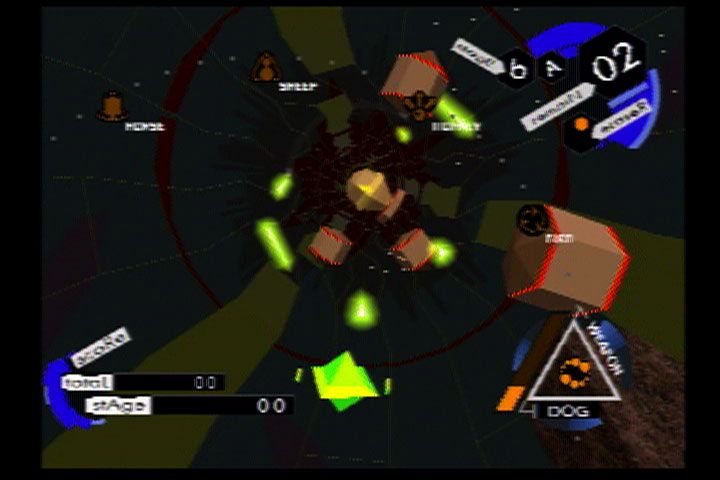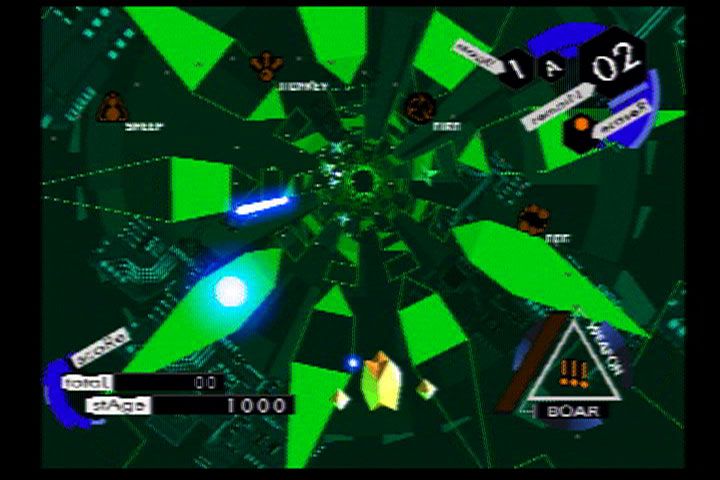Retro Replay Review
Gameplay
iS: internal section leans heavily into the classic “tube shooter” formula established by Tempest and S.T.U.N. Runner, delivering intense, high-speed action that tests your reflexes at every twist and turn. You pilot a sleek, luminescent craft through winding tunnels, blasting waves of enemies and obstacles that emerge from all directions. The core loop is deceptively simple—navigate the tube, clear enemies, and advance—but the game’s relentless pace and precision requirements keep you fully engaged from start to finish.
(HEY YOU!! We hope you enjoy! We try not to run ads. So basically, this is a very expensive hobby running this site. Please consider joining us for updates, forums, and more. Network w/ us to make some cash or friends while retro gaming, and you can win some free retro games for posting. Okay, carry on 👍)
What truly sets the gameplay apart is the arsenal of twelve weapons, each named after an animal of the Chinese zodiac. Swapping between the agile Rat to the explosive Dragon or the homing capabilities of the Snake adds a strategic layer to the frenetic shooting. Each weapon has its own firing pattern, fire rate, and energy usage, encouraging you to experiment and master combinations that suit different tunnel layouts and boss encounters. This deep arsenal ensures that no two runs feel quite the same.
Beyond the arcade-style campaign, iS offers unique modes that leverage the PlayStation’s CD drive. By inserting your own music CDs, you can trigger dynamic changes in enemy waves, color schemes, and tunnel patterns. This feature extends replayability considerably, inviting players to craft custom challenges around their favorite techno or electronic tracks. Whether you’re chasing high scores or chasing the perfect synth beat, the gameplay remains tight, responsive, and endlessly replayable.
Graphics
Visually, iS: internal section opts for flat-shaded, untextured polygons that may at first glance appear minimalist, but this deliberate choice serves performance and style in equal measure. Running in the PlayStation’s high resolution mode, the game maintains a rock-steady frame rate even during the most chaotic sequences. The absence of textures keeps your focus on the geometry and movement, creating a hypnotic look that feels both retro and ahead of its time.
Color plays a starring role here, with neon hues shifting dynamically in sync with the in-game techno soundtrack or imported CD tracks. As you progress through each level, tunnel walls pulse and glow, enemies flash different colors, and the entire environment morphs around you. This visual feedback not only heightens immersion but also gives subtle cues about enemy behavior or incoming hazards. It’s a sensory feast that rewards attentive players.
While modern gamers accustomed to photorealism might find the aesthetic stripped-down, the geometric abstraction is part of the game’s charm. The minimalism creates a clean canvas for frantic action, reducing visual clutter in tight spaces. It also aligns iS with other experimental titles of its era—think early Rez or Vib-Ribbon—where style and performance were balanced to achieve unique audiovisual experiences on the PlayStation hardware.
Story
Unlike narrative-driven titles, iS: internal section presents its premise through sparse text screens and evocative aesthetics rather than cutscenes or dialogue. You are a virtual operator delving into a hostile internal system to neutralize a spreading corruption. Each tube represents a layer of the digital environment, and defeating bosses clears blocks of infected code. The bare-bones plot leaves much to the imagination, encouraging players to weave their own sense of purpose as they accelerate deeper into the machine’s core.
The abstract narrative design complements the gameplay’s rhythmic intensity. There’s no downtime for exposition or character development—just you, your craft, and the ever-tightening corridors of the system. This minimal storytelling approach keeps the focus squarely on action, creating a trance-like state reminiscent of arcade shooters or early rhythm-action hybrids. If you crave a rich backstory, you might miss traditional cutscenes, but if you prefer high-octane immersion, iS delivers.
Subtle environmental cues, such as shifts in color palette or music tempo, hint at narrative progression without breaking pace. Boss encounters feel like breakthroughs in your mission to purge the system, and each successful stage completion provides a quiet moment to reflect on the scale of what you’re combating. The result is a concise, impressionistic storyline that serves the core shooter experience rather than overshadowing it.
Overall Experience
iS: internal section stands as an ambitious blend of arcade shooting, techno-driven audiovisuals, and emergent customization through CD-based modes. Its high-speed tunnels, strategic weapon variety, and dynamic color shifts deliver a captivating wave of sensory stimuli. While the story is minimal, the abstract premise fuels your drive to push further, clear stages, and discover new visual and auditory surprises.
This title especially shines for fans of retro-inspired shooters and those who appreciate experimental features. The ability to load your own music CDs creates endless possibilities, transforming familiar tracks into interactive levels tailor-made by the game’s engine. Even three years before titles like Rez popularized rhythm-shooter hybrids, iS was already exploring the marriage of music and gameplay.
In an era where many PlayStation games aimed for texture-heavy environments and cinematic storytelling, iS: internal section took a different path—one of geometric purity and pulse-pounding immediacy. It may not cater to every mainstream taste, but for players seeking a focused, high-energy experience that marries audio and action in novel ways, iS remains a hidden gem well worth exploring.
 Retro Replay Retro Replay gaming reviews, news, emulation, geek stuff and more!
Retro Replay Retro Replay gaming reviews, news, emulation, geek stuff and more!








Reviews
There are no reviews yet.